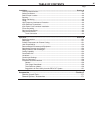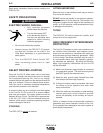
B-1
OPERATION
PRO-CUT 55
B-1
Read and understand this entire section before oper-
ating the machine.
SAFETY PRECAUTIONS
DESCRIPTION
The Pro-Cut 55 is a constant current, continuous con-
trol plasma cutting power source. It provides superior
and reliable starting characteristics, cutting visibility
and arc stability. When cutting expanded metal, the
Pro-Cut 55 out performs the competition due to its
quick, clean response to arc transfers. The power
supply design provides high transfer-to-cut distances
which makes pierce cutting more reliable and with
less nozzle wear. The control system has a safety
mechanism to insure that the nozzle and electrode are
in place before cutting or gouging. This is extremely
important due to the high voltages involved.
The Pro-Cut 55 comes standard with an air regulator,
coarse air filter, and pressure gauge. The machine
also comes with an 11' input power cord. There are
four different torch and cable systems to choose from:
hand-held torch with 25' or 50' cable, machine and
robotic torch both with 25' and 50' cable.
Consumables are included with each Pro-Cut pur-
chase so that cutting can begin right out of the box.
Consumables can also be ordered as individual pack-
ages. An undercarriage kit can also be ordered sepa-
rately.
The Pro-Cut 55 initiates the plasma arc with a simple,
yet reliable, touch start mechanism. This system elimi-
nates many of the failure problems associated with hi-
frequency start systems. The Pro-Cut 55 is capable of
cutting with nitrogen or air. Nitrogen is used to cut alu-
minum and other nonferrous metals.
The Pro-Cut 55 is controlled by a microprocessor-
based control board. The machine performs rudimen-
tary self troubleshooting when powered up which aids
in field servicing.
PREHEAT TEMPERATURE FOR
PLASMA CUTTING
Preheat temperature control is not necessary in most
applications when plasma arc cutting or gouging.
Preheat temperature control may be necessary on high
carbon alloy steels and heat treated aluminum for crack
resistance and hardness control. Job conditions, pre-
vailing codes, alloy level, and other considerations may
also require preheat temperature control. The following
minimum preheat temperature is recommended as a
starting point. Higher temperatures may be used as
required by the job conditions and/or prevailing codes.
If cracking or excessive hardness occurs on the cut
face, higher preheat temperature may be required. The
recommended minimum preheat temperature for plate
thickness up to 1/2" (12.7mm) is 70°F (21.1°C).
ELECTRIC SHOCK
can kill.
• Do not touch electrically live parts
or electrode with skin or wet
clothing.
• Insulate yourself from work and
ground.
• Always wear dry insulating
gloves.
FUMES AND GASES
can be dangerous.
• Keep your head out of fumes.
• Use ventilation or exhaust to
remove fumes from breathing
zone.
WELDING, CUTTING and
GOUGING SPARKS
can cause fire or explosion
• Keep flammable material away.
• Do not weld, cut or gouge on
containers that have held combustibles.
Observe additional Safety Guidelines detailed in
the beginning of this manual.
WARNING
ARC RAYS
can burn.
• Wear eye, ear and body
protection.
PLASMA ARC
can injure
• Keep your body away from nozzle
and plasma arc.
• Operate the pilot arc with caution. The
pilot arc is capable of burning the
operator, others or even piercing
safety clothing.


















